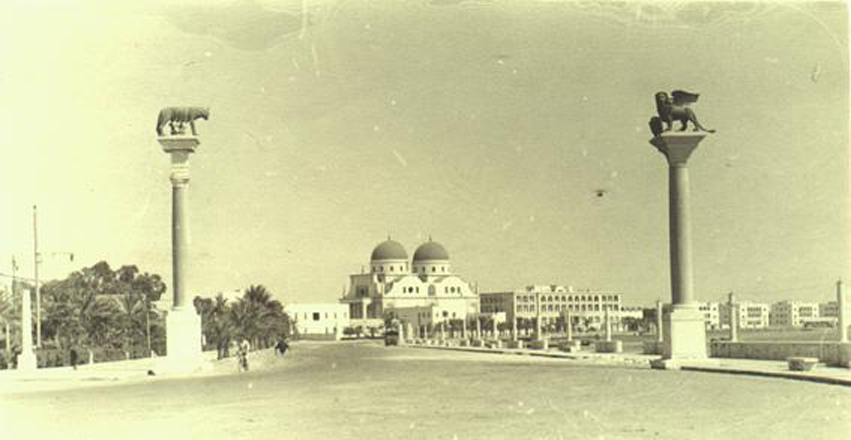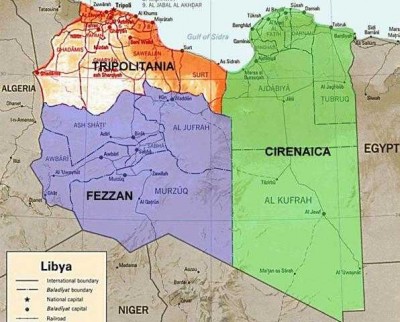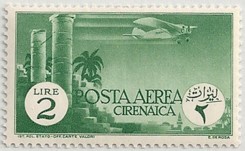ALBUM – view my Cyrenaica album
TRANSITION CHART – Libya Area
Fast Facts
Region: North Africa
Group: Libya Area
Classification: Italian Colonies
Prior Regime: Italian North Africa
Key Dates:
1911, Sept 29 – Italians launch an attack on Libya against the Ottomans
1912, Oct 18 – Ottomans ceded Libya to Italy
1919, Nov 12 – Cyrenaica was established as an Italian Colony
1934, Jan 1 – Tripolitania, Cyrenaica, and Fezzan joined to form the Italian colony of Libya.
Following Regime: Italian Colony of Libya
Scott Catalogue: (Cyrenaica) 1-64, B1-B33, C1-C29, CB1-CB10, CBO1
Pick Catalogue: none
History

Historically, Libya has been divided into three regions, Tripolitania, Cyrenaica and the southern desert region of Fezzan. For about 350 years, Libya was controlled by the Ottoman Empire. As Italy desired to become a colonial power, they signed a secret pact in 1902 with France agreeing to not interfere with the other as they invaded areas of North Africa. For the next 10 years, Italy did little to realize the “opportunity”, however in launched an invasion in the region on Sept 29, 1911. As full scale war broke out, the superior naval power of Italy aided the Italian capture of Tripolitania, Cyrenaica, Fezzan and the Dodecanese Islands in the Aegean Sea.
The Italian victories encouraged other nations to take advantage of a weakened Ottoman Empire. On Oct 12th, 1912 Serbia, Greece, Bulgaria and Montenegro allied together and launched attacks in Ottoman held areas of the Balkans starting the 1st Balkan war. In order to protect territory closer to home, the Ottomans quickly ended the war in Libya by ceding Libya to Italy and allowing Italian “administration” of the Dodecanese Islands. The agreement was ratified in the Oct 18, 1912 Treaty of Ouchy.
The Italians began setting up an administrative structure in the region, but as World War I broke out in 1914, they withdrew the bulk of their troops, only to maintain control of a few coastal towns. This allowed control of the bulk of the country to the local Senussi tribes. After the war, Italy essentially needed to re-take the region as the local tribes’ fiercely resisted Italian rule. On 17 May, 1919 Cyrenaica was proclaimed as a colony, but it would take many difficult years for the Italians to gain power.
While Tripolitania was quickly subdued by Italian forces, Senussi tribes in Cyrenaica, led by Omar al-Mukhtar, put up strong resistance. As Mussolini and the fascists assumed control in Italy, the Italians resorted to brutal tactics against the tribal people of Cyrenaica. Executions, sealing wells and dropping people from airplanes were commonplace. Beginning in 1930, the Italians forced 100,000 men, women and children into concentration camps where most are believed to have died. Ultimately al-Mukhtar was captured and hanged in 1931, while Italian operations in Cyrenaica probably resulted in the deaths of one-half to two-thirds of the population.
On 1 Jan, 1934, Tripolitania and Cyrenaica along with the Military Territory of Fezzan were combined to form the single Italian Colony of Libya. The colony lasted until World War 2, when British troops eventually drove all Italian and German forces out of Libya in Feb, 1943.
Stamps
Throughout the period of the individual colonies, Tripolitania and Cyrenaica issued separate commemorative, air post and authorized delivery stamps. However definitive, parcel post, postage due and express stamps were combined and issued under the name of “Libia”.
The first stamps for Tripolitania, were issued on 24 Oct, 1923, by overprinting the 4 stamps in the Italian “Propaganda for the Faith” series with “CIRENAICA” in black. Many Italian commemorative series continued to be overprinted “Tripolitania” in various colors and fonts for the entire existence of the colony. The overprinted sets are:
“Propaganda for the Faith” Series – 1923, Oct 24
“Fascisti” or “March on Rome” Series – issued 1923, Oct 29
“Manzoni” Series – issued 1924, Apr 1
“Victor Emmanuel” Series – issued 1925 – 1926
“Saint Francis of Assisi” Series – issued 1926, Apr 12
“Volta” Series – issued 1927, Oct 10
“Monte Cassino” Series – issued 1929, Oct 14
“Royal Wedding” Series – issued 1930, Mar 17
“Ferrucci” Series including air post – issued 1930, Jul 26
“Virgil” Series including air post – issued 1930, Dec 4
“St. Anthony of Padua” Series – issued 1931, May 2
“Holy Year” Series – issued 1925
“Charitable work of the Voluntary Militia for Italian National Defense” Series – issued 1927, Apr 21, 1929, Mar 4, 1930, Oct 20
Additionally, the Italians overprinted Italian air post semi-postal (charity stamps), air post, official, air post semi-postal special delivery and authorized delivery stamps.
Additionally, various series of stamps were specially printed for use in Cyrenaica, including a Colonial Institute Issue (featuring a common design from the colonies) issued on Jun 1, 1926, several Air Post series, and two special flight issues. The stamps of Italian Cyrenaica (and indeed Tripolitania) are fascinating examples of the bold fascist artistic style called “futurism”. While many of the issues are overprints of Italian stamps, the audacious graphics from the era can indeed be mesmerizing.
Lastly, two beautiful photogravure sets (one regular and one Air Post) were issued on Oct 16, 1934, for the 2nd Colonial Arts Exhibition in Naples, even though this was after the official dissolution of the separate colonies.
Note that Scott #’s normally denotes a semi-postal stamp (those with an extra surtax beyond postage) with the prefix “B”. However, since many series of Italy and the Italian Colonies stamps include one or more semi-postal stamps, these issues are generally listed as regular postage, airmail stamps unless all the stamps in the series carry the surtax.
Banknotes
Italian currency was used in Cyrenaica.
Links
Libyan History: Italian Colonization (1911-42)
History of Libya from History World
Libya History from WorldStatesman
Postage Stamps of Cyrenaica






Great article once again. I learn so much from reading your blog, Michael.
I’m always conflicted looking at these Italian Fascist stamps because they stamps are beautiful yet the regime was ugly.
Hi Mark, thank you for the nice comment. I agree with you regarding the Fascist artwork. It is hard to find adjectives which describe beautiful and awful mixed together.
Michael
Interesting history lesson and, as always, Beautiful pages!!!
Thanks Jon – glad you like them